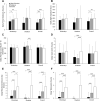Baseline characteristics in the Israel refraction, environment, and devices (iREAD) study
- PMID: 36806309
- PMCID: PMC9938253
- DOI: 10.1038/s41598-023-29563-3
Baseline characteristics in the Israel refraction, environment, and devices (iREAD) study
Abstract
The purpose of this study is to present baseline data from a longitudinal study assessing behavioral factors in three groups of boys in Israel with varying myopia prevalence. Ultra-Orthodox (N = 57), religious (N = 67), and secular (N = 44) Jewish boys (age 8.6 ± 1.4 years) underwent cycloplegic autorefraction and axial-length measurement. Time-outdoors and physical-activity were assessed objectively using an Actiwatch. Ocular history, educational factors, and near-work were assessed with a questionnaire. Group effects were tested and mixed effects logistic and linear regression were used to evaluate behaviors and their relationship to myopia. The prevalence of myopia (≤ - 0.50D) varied by group (ultra-Orthodox: 46%, religious: 25%, secular: 20%, P < 0.021). Refraction was more myopic in the ultra-Orthodox group (P = 0.001). Ultra-Orthodox boys learned to read at a younger age (P < 0.001), spent more hours in school (P < 0.001), spent less time using electronic devices (P < 0.001), and on weekdays, spent less time outdoors (P = 0.02). Increased hours in school (OR 1.70) and near-work (OR 1.22), increased the odds of myopia. Being ultra-Orthodox (P < 0.05) and increased near-work (P = 0.007) were associated with a more negative refraction. Several factors were associated with the prevalence and degree of myopia in young boys in Israel, including being ultra-Orthodox, learning to read at a younger age, and spending more hours in school.
© 2023. The Author(s).
Conflict of interest statement
All authors certify that they have no affiliations with or involvement in any organization or entity with any financial interest (such as honoraria; educational grants; participation in speakers' bureaus; membership, employment, consultancies, stock ownership, or other equity interest; and expert testimony or patent-licensing arrangements), or non-financial interest (such as personal or professional relationships, affiliations, knowledge or beliefs) in the subject matter or materials discussed in this manuscript. The authors declare no competing interests.
Figures



References
-
- World Health Organisation . The Impact of Myopia and High Myopia: Report of the Joint World Health Organization: Report of the Joint World Health Organization-Brien Holden Vision Institute Global Scientific Meeting on Myopia. University of New South Wales; 2015. pp. 1–40.
Publication types
MeSH terms
Grants and funding
LinkOut - more resources
Full Text Sources

